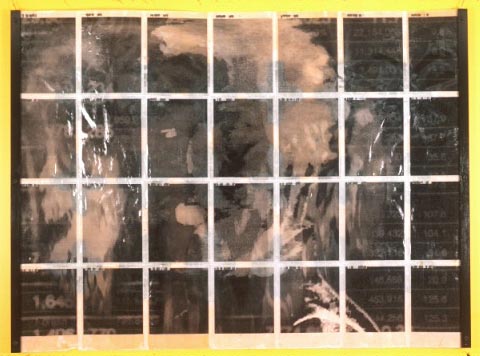Artist Statement

Photography, Acrylic Glaze
The Digital Movie
I am representing modern advertising as Art. Religious Art of previous centuries attempted to depict a fantastic and divine utopia (that society's ideological aspiration) as palatable graphic stories - as physical realities - just as advertising, as an art form, similarly depicts today's populist' aspirations and ideologies (albeit a slightly less ambitious vision).
Advertising has become a more effective mirror of populist values and a heavier hammer in shaping future cultures, challenging some one-time interpretations of "Art'.
With the popularization of graphic design within this century, Advertising Art has also mastered popular concepts of beauty in its imagery and, arguably, even advances new concepts of beauty, as well as stimulating social trends.
I chose to use digital video as a medium because it resembles the most dynamic vehicle for advertisers- the TV spot. Conceptually, the work is a mutation. It is fundamentally a found object AND a found concept, in which I embed new meaning, context and structure. Little of the imagery even closely resembles the original, and NONE of the original concept or intent remains.
I wanted to exaggerate the chaotic clutter of current media and alarm viewers with the schizophrenic result-not unlike the spontaneous shifts caused by typical commercial interruptions during news programs or hyper-dramatic soaps. Digital video further accommodates nonlinear thought to an even higher degree than did the technologies that brought TV, radio, and newspapers. Fundamental thought patterns established as long ago as ancient Greece are being altered as a direct result of current technology irregardless of the messages being delivered.
The looping movie is a kind of media free association, where my color, structure and movement are transformations of many video clips superimposed over each other, rotoscoped (drawn onto), confused by frequent changes of context and contorted by changes in speed. The short movies frequently include footage that I filmed myself, in addition to the appropriated advertising spots taken from commercial broadcasts.
The Hanging Screens
The final hanging screen is literally a time-lapse composite of media metamorphosis. It has gone from a highly dynamic, flowing, moving image to a frozen still carefully rendered over 112 minutes - completely static - a mosaic with mortar of polyester resin, synthetic sinew of plastic, transparent tape, and black latex blemishes - elements of nearly every modern office or home. Each individual tile of the final mosaic takes four minutes to print and the time, date and location are notated in each tile of the complete mosaic.
All images are 'stills', images pulled from the digital movie, converted into picture elements, and printed on a Laserwriter at nearly twelve times their original size. Physical transiency is a key element to these pieces. To appreciate these changes, I've described the work below:
Commercial broadcast television and my own video footage are first recorded live or at home onto VHS tape and brought to my studio at school to be digitally captured on a computer's hard drive. I alter them (a lot) and edit the new dips, juxtaposing them by replacing context. A single video frame (1130th of a second in duration) from the new movie is grabbed, converted into a picture element within a digital imaging program (Adobe Photoshop) and printed out on a printer from the first floor computer lab. At this point, the medium has traveled from its original location (my living room) approximately three city blocks and changed from its original air-wave signal to analog video, to a QuickTime digital movie, to a TIFF graphic, and finally, enlarged and printed onto vellum.




